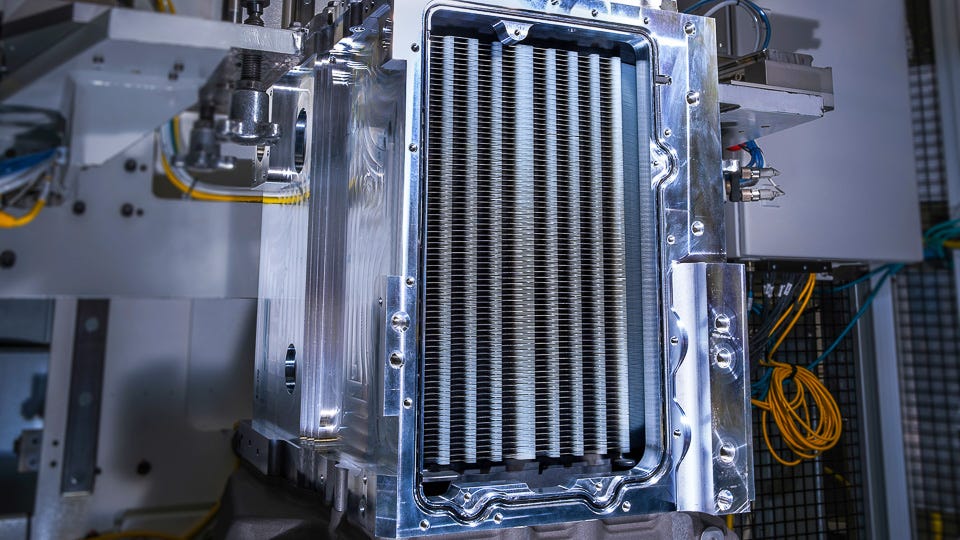There are many people who believe that much of the power generation of the future will be through the use of fuel cells. They are already being used in various capacities, and the technology is rapidly advancing, which will soon enable even more practical and larger applications. This article will briefly look at fuel cell basics, current applications, and how it can be used in the future.

Fuel Cell Basics
A fuel cell is basically a battery and it works in the same way as illustrated in the below flash animation. It uses a fuel, most often hydrogen, as the electrolyte. An advantage they have over batteries is that they do not run down. They also produce no pollutants, but will produce water as a by-product, as well as heat.
In order to produce power, the fuel in a fuel cell has to be supplied continually. Two fuels are needed, and the most common are hydrogen and oxygen, or air may be used. There are also two electrodes and two screens. An electrolyte such as potassium hydroxide will fill in the gap between the screens. The different gases are put into the fuel cell at each electrode, one positive and one negative. This causes a chemical reaction and a direct-current voltage is produced.
At the anode in the fuel cell, the hydrogen atoms are stripped of their electrons, leaving only the protons. A polymer membrane separates the two electrodes, and the electrons are then forced to ride an external circuit before they can reach the cathode. This flow of electrons creates the electricity. In order to generate a sufficient amount of energy, a stack of fuel cells is required.
A strong reason to continue to develop fuel cell technology is because a fuel cell is able to convert the fuel directly into electrical energy, whereas an internal combustion engine must first convert the fuel into mechanical energy, which can then convert it into electrical energy. In order to make it even more efficient, various types of fuel cells are being developed.
Other types of fuel cells can also produce electricity. They use a wide variety of fuels, such as a phosphoric acid fuel cells (PAFCs); a molten carbonate fuel cells (MCFCs) – which operates at temperatures around 650 °C; a solid oxide fuel cells (SOFCs) – which operates at temperatures between 800 and 1,000 °C: and more. In each fuel cell, there is a definite need to be able to control and remove excess heat. The most practical way, which also increases the efficiency, is to convert the heat into electricity as well. Some of these electrolytes are liquid, but some are solids.
Application
Fuel cells are already in use in a variety of applications. Because of their ability to continually generate power as long as there is a supply of fuel, they can be used to supply power for almost anything – from laptops, to spacecraft, to whole cities. They are easily scalable to fit any need.
A powerful advantage of a fuel cell over conventional sources of power, such as coal or gas power generation stations, is that they convert energy much more efficiently. Naturally, when oxygen and hydrogen recombine inside, large amounts of heat and pressure will be produced. This requires strong containers that can withstand both.
Fuel cells are currently being used in a number of applications today. They are already being used in vehicles of all sizes. One of the first uses was in the Gemini spacecraft, and three of them powered each of the space shuttles, generating up to 12,000 watts at 27.5 volts. The thing that makes them attractive to the power industry is that they produce energy more efficiently, and they do it with zero emissions.
There are three main types of applications of fuel cell technology today, portable, in transportation, and in permanent stationary installations. Stationary applications are the largest, and they are used to power hospitals, homes, military bases, schools, airports, and more.
While fuel cells do power some cars today, there is a problem that may prevent it from going mainstream. The necessary ingredient, which does not exist today, is the availability of hydrogen to refuel cars powered by fuel cells. A strong advantage, though, is that a tank of hydrogen can be refilled in 15 minutes, or less, whereas, an electric car takes many hours to be fully recharged. Although the technology is there, the infrastructure is not, which means other developments in the auto industry may overtake it – such as hybrid or electric vehicles.
Pure hydrogen is not always necessary. Some fuel cells use hydrocarbons in the form of natural gas or even gasoline, but it must be converted to hydrogen by a fuel reformer. When this process is used, it cuts the efficiency of the fuel cell by 25 percent.
Future Implementation
The future of fuel cells continues to be bright. Some changes are still necessary, however, before it can become a mainstream source of power for the masses. Researchers need to be able to get a higher percentage of power conversion from the units, which is currently about 60 percent for some forms. A second problem is the cost. They cannot yet compete with the cost of more traditional energy sources. Some of the necessary technology has yet to be developed.
Conclusion
Even though fuel cells have come a long way, more development is still necessary. It is very clear that other forms of power generation must be developed because oil and gas are limited, and the pollution is too high to continue to use them at the same rates.


